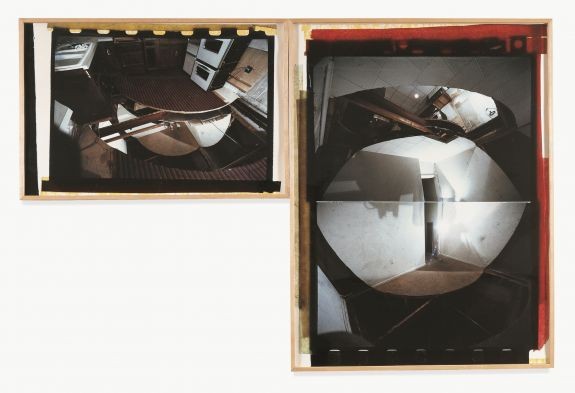MCA DNA: Gordon Matta-Clark
12 Nov 2011 - 29 Apr 2012

Gordon Matta-Clark, Circus or The Caribbean Orange, 1978.
Collection Museum of Contemporary Art Chicago, restricted gift of Mr. and Mrs. E. A. Bergman and Susan and Lewis Manilow, 1978.1.a-b.
© Estate of Gordon Matta-Clark. Photo © MCA Chicago
Collection Museum of Contemporary Art Chicago, restricted gift of Mr. and Mrs. E. A. Bergman and Susan and Lewis Manilow, 1978.1.a-b.
© Estate of Gordon Matta-Clark. Photo © MCA Chicago
MCA DNA:
GORDON MATTA-CLARK
12 November, 2011 – 29 April, 2012
Part of an ongoing series featuring works that constitute the building blocks of the MCA Collection, MCA DNA: Gordon Matta-Clark presents Circus (alternately titled The Caribbean Orange), the last major project by artist Gordon Matta-Clark (American, 1942–78). In the 1970s, Matta-Clark became known for cutting into abandoned New York buildings to create installations that bridged architecture and sculpture—a practice he called “anarchitecture.” Embracing the artist’s challenging working methods, the MCA invited Matta-Clark to Chicago to create a new work in an adjacent building slated for renovation into additional museum galleries. In February 1978, he created Circus, or The Caribbean Orange by removing large circular forms from the ceilings, walls, and floors, resulting in a “spherical shape along a diagonally ascending axis” that exposed the interior to sun and snow. As planned, this temporary work was covered up with the renovation of the annex.
Circus, or The Caribbean Orange intervened into the building at 235 East Ontario Street using a logic that was difficult to comprehend by merely visiting the installation; the curvilinear progression cut through all four stories so that it was impossible for the viewer to take in the entire work at once. Photography and drawing, therefore, became essential to the project. Having trained as an architect, Matta-Clark made a plan and section that provide the viewer with additional information. Furthermore, rather than using straight photography to document the completed work, he created several color photo montages that strive to convey the experience of the sculptural space, for no single photographic view could begin to capture the whole installation. Similarly, for the exhibition catalogue, Matta-Clark created a series of photo collages in which he attempted to represent some semblance of the work’s reality. In these ways, the site of Circus, or The Caribbean Orange was both a work in itself and a source for the photographic works on view.
GORDON MATTA-CLARK
12 November, 2011 – 29 April, 2012
Part of an ongoing series featuring works that constitute the building blocks of the MCA Collection, MCA DNA: Gordon Matta-Clark presents Circus (alternately titled The Caribbean Orange), the last major project by artist Gordon Matta-Clark (American, 1942–78). In the 1970s, Matta-Clark became known for cutting into abandoned New York buildings to create installations that bridged architecture and sculpture—a practice he called “anarchitecture.” Embracing the artist’s challenging working methods, the MCA invited Matta-Clark to Chicago to create a new work in an adjacent building slated for renovation into additional museum galleries. In February 1978, he created Circus, or The Caribbean Orange by removing large circular forms from the ceilings, walls, and floors, resulting in a “spherical shape along a diagonally ascending axis” that exposed the interior to sun and snow. As planned, this temporary work was covered up with the renovation of the annex.
Circus, or The Caribbean Orange intervened into the building at 235 East Ontario Street using a logic that was difficult to comprehend by merely visiting the installation; the curvilinear progression cut through all four stories so that it was impossible for the viewer to take in the entire work at once. Photography and drawing, therefore, became essential to the project. Having trained as an architect, Matta-Clark made a plan and section that provide the viewer with additional information. Furthermore, rather than using straight photography to document the completed work, he created several color photo montages that strive to convey the experience of the sculptural space, for no single photographic view could begin to capture the whole installation. Similarly, for the exhibition catalogue, Matta-Clark created a series of photo collages in which he attempted to represent some semblance of the work’s reality. In these ways, the site of Circus, or The Caribbean Orange was both a work in itself and a source for the photographic works on view.
